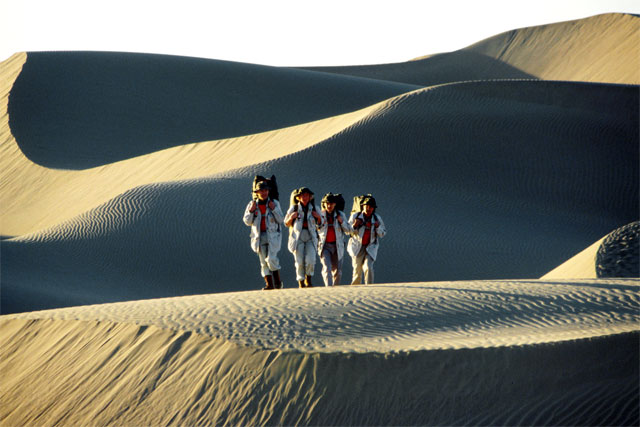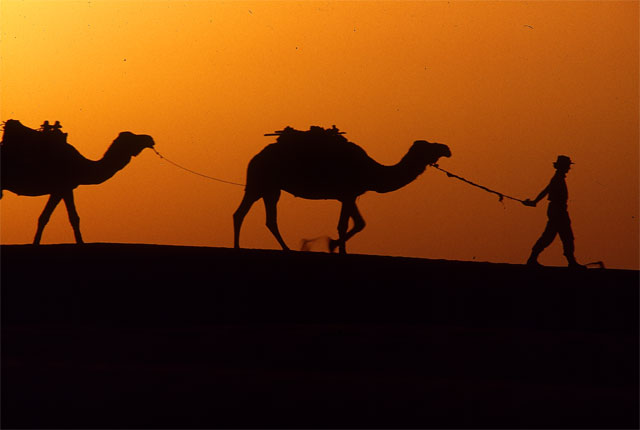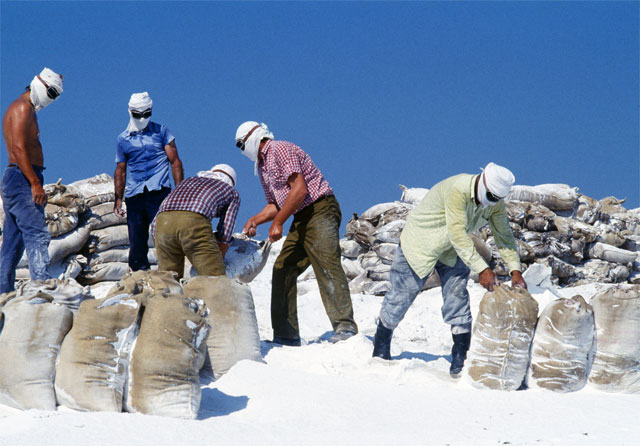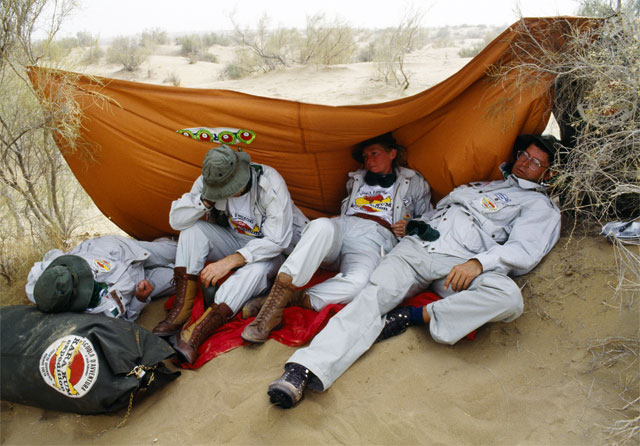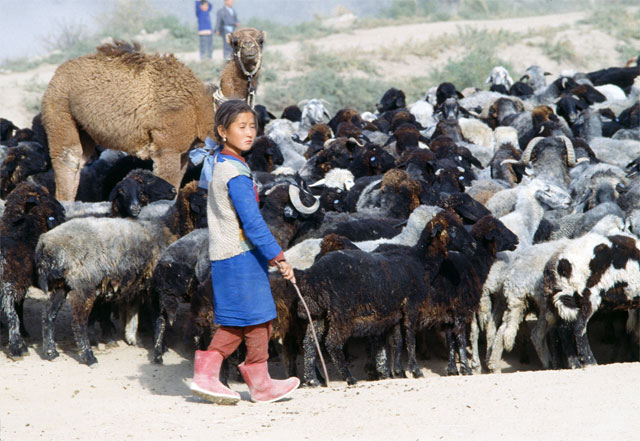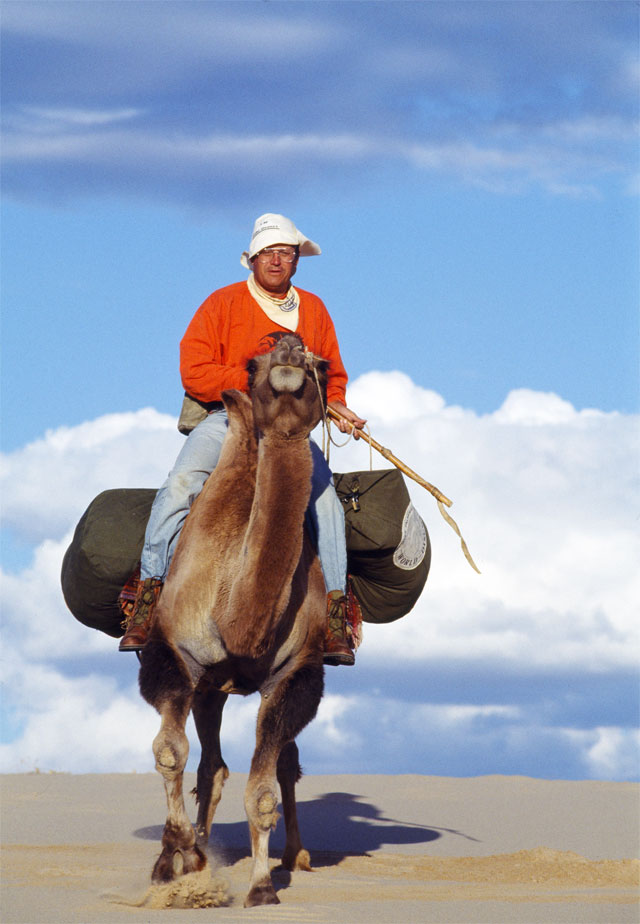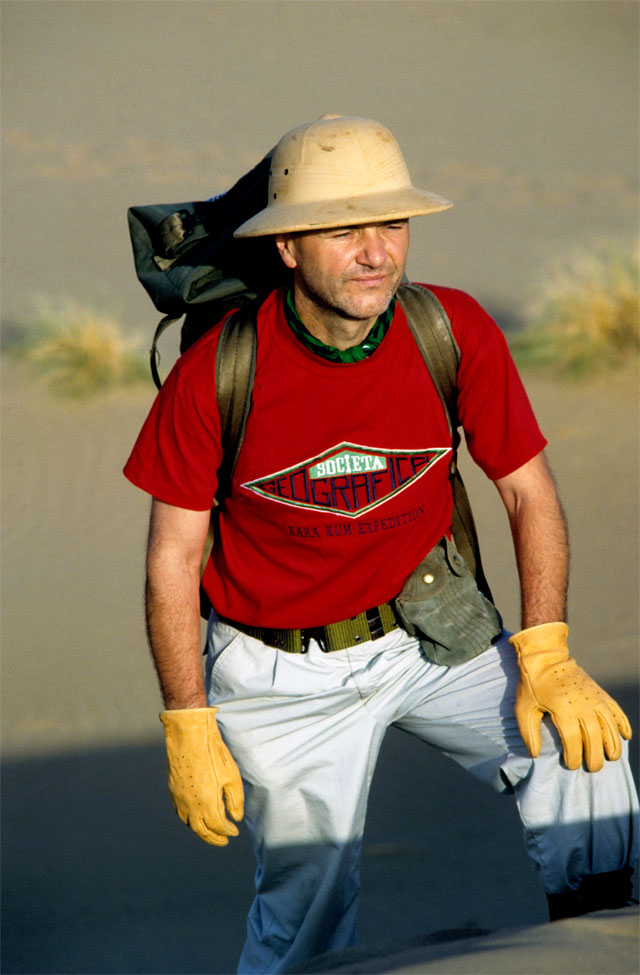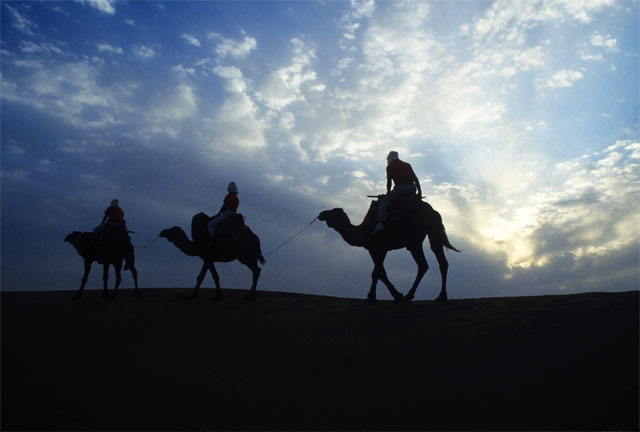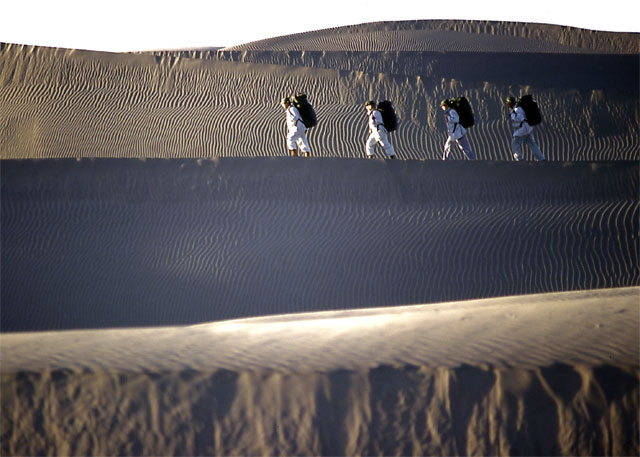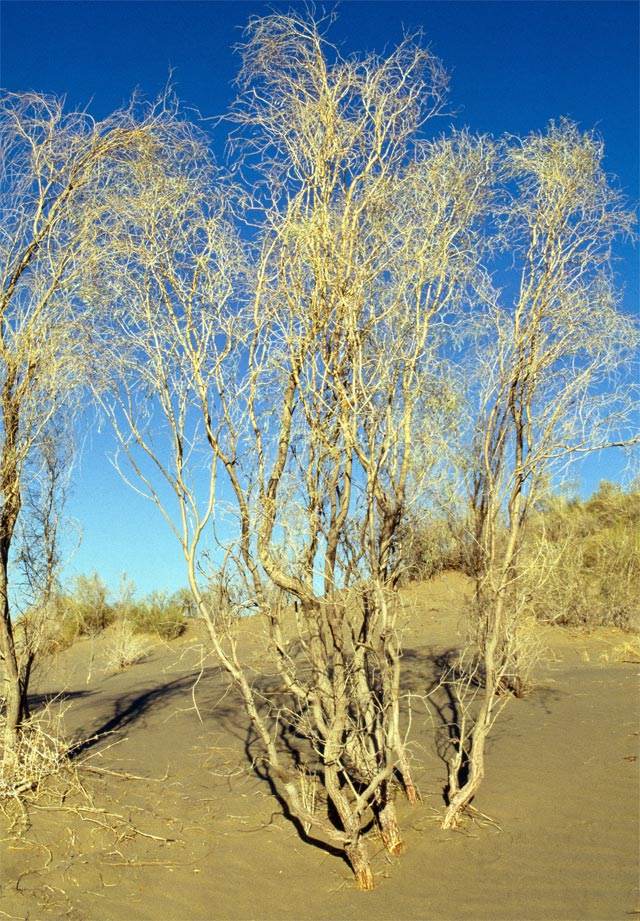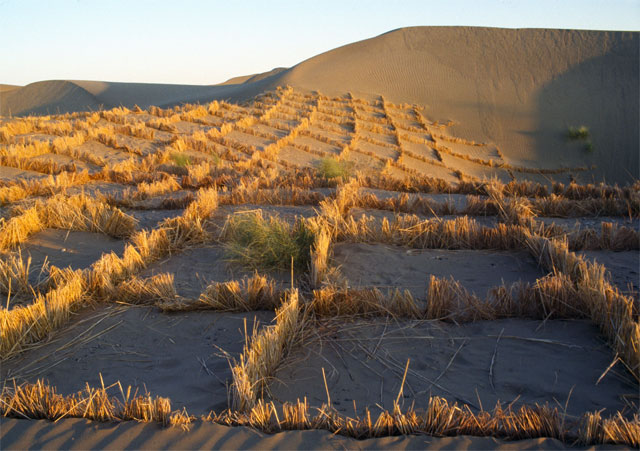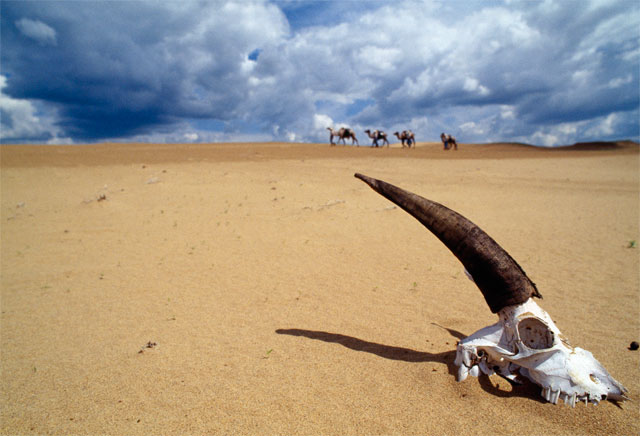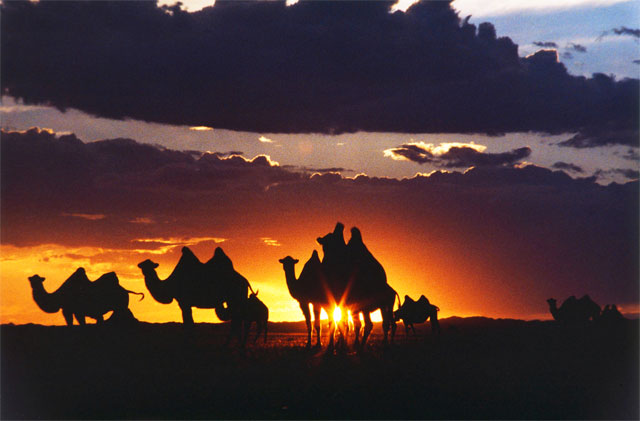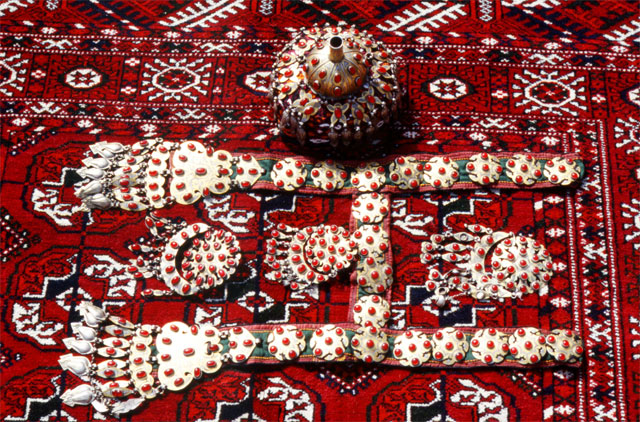A message scrawled in peeling white paint on the rusting side of one of the many fishing boats stranded on the sand summed up the situation : “Good-bye Aral!”
I looked upon the tragic death of Lake Aral, one of the Soviet Union’s greatest ecological disasters, with some bitterness. We in the west know almost nothing of this environmental catastrophe. In just twenty years the lake’s water level has fallen by 14 meters and its waters have retreated as much as 150 kilometers from its former banks.
This drastic alteration is due to man. More particularly, it is the fault of there having been dug a 1350-kilometer long irrigation canal from the river Amu Daria, Aral’s main tributary, to the southernmost part of the Kara Kum desert, which has been dry for centuries. When the immense project was planned no-one could have imagined that it would create such serious ecological problems, but these problems nevertheless now exist. Besides, the scheme has not even made as much use of the Amu Daria’s waters as was once expected. The canal runs between tow sandy banks and thus loses 30% of its flow to drainage and evaporation.
The fishermen have had to invent new forms of work for themselves. The massive fish-processing plant on Aral’s shores, which employs 1550 workers, continues to work only as a result of the transportation of 7000 tons offish from the Pacific Ocean every year. Meanwhile, the whole of Amu Daria basin is dying, its water and plant life are disappearing inexorably and the salt content of the river has risen from 4 parts per thousand to 23 parts per thousand.
The whole region is rapidly becoming desert. Salt carried from the dried up area of the lake has rendered land uncultivable as far as 300 kilometers away and has been blown 1000 kilometers to India.
Professor Sirbay Bazarbay often perfaces his remarks with the statement: “When the sea still existed…”. He has been working for the Karakalpatzk branch of the laboratory studying Aral’s problems since 1976. He refused, however, to divulge too many facts and figures to me. “We have the highest rate of illnesses in the USSR, even mothers’ milk is toxic. In this area water is so intensly employed for agriculture, via the canals, that it becomes undrinkable. Pesticides and other chemical products, including ammonium sulphate, are dumped in the lake willy-nilly, after being used to increase cotton production”.
The professor, who is a small-statured man of great stubborness, is carrying on an unequal struggle against the authorities. “The proportion of salt has continued to increase”, he told me, “But this still isn’t the worst problem. Temperatures have also changed, rising by 3-4 degrees more in summer and falling by equal amounts in winter. There is enormous interest in the wealth that lies hidden underground here, but nobody does anything about cleaning up the ground itself. I’m working with all my heart because I was born here, I live here, my children live here and I shall die here”. The Professor looked around him, at the sand dunes dotted over what had once been the now remote sea shore and said :” When the sea still existed…” as if he was talking about the distant past.
I had striven for some time to obtain a permit to visit this area, which is generally forbidden to westerners. At last I could satisfy my keenly-awaited wish to cross the Turkmenistan desert over the ancient caravan-way for Ciardzou, which means “meeting of four roads”, all four of which are by-ways of the silk road.
This land, which is so poor and barren, hides gas, oil and gold. As a result the nomads have grown used to seeing exploration wells drilling in the subsoil while their camels now graze on the scarse foliage of this territory amidst the tracks made by jeeps and lorries carrying supplies to the oil wells.
The people live contemporaneously in two worlds. They are still attached to their old ways, but now have access to all kinds of modern gadgets. People still draw water from wells by the time-honured methods and bake bread in the conical ovens which seem like little volcanoes. At the same time the villages can boast electric light, the radio, shops which sell clothes, cigarettes, batteries and plastic trays.
The women of Turkmenistan, who are Indo-European in appearance, do not wear the veil, despite being Muslims. They will, however, bow their heads and cover their mouths with a corner of their “kainats”, kerchief, as a sign of respect towards old people. Their clothes are the same as their mothers’ and grandmothers’: highly coloured dresses which fall to their ankles, and trousers with patiently embroidered fringes. This traditional garb is worn with pride since the women are proud to belong to one of the twenty ancient tribes of the Turkmenistan race. Their main work is raising children. Most families are large sihce children are still considered a source of wealth. “God gives you them, God takes them away”, they say resignedly, whenever one of their 10-15 offspring dies. Having fewer children would almost be considered a family disgrace.
In a commune near Ciardzou, I had a chat with Karryev. He was the oldest man in the village and sported a long wide beard, a long cotton coat and sheepskin waistcoat, or “telpek”. He said he had 62 grandchildren : 38 boys and 24 girls. He was very content about his preponderance of boys, if there had been more girls than boys he would have considered that he had no reason to boast. Male heirs are vital in this culture. A woman who has never given birth to a boy literally remains without name. Then when her first sons are born, she becomes “Ummm-Ali, Umm-Ahmed”, mother of Ali, mother of Alimed.
I asked the secretary of the “Ciapayev” commune for information about the traditional “kalym” or dowry paid by the bride’s father. He looked at me angrily. “These practises no longer exist”, he declared with some heat. An hour later, during a wedding supper, the father of the groom told me quite openly that he had paid 7000 rubles, which was about four years’ work at the average wage rate.
Many young women, however, have rebelled against this practice in a violent and irreversible way. In 1989, 800 of them doused themselves in petrol and then set themselves alight rather than submit to marrying men their fathers had chosen for them. One girl told me tearfully that she had seen the charred remains of a friend of hers. “Another time I saw a young girl I didn’t know burning. She was wrapped in flames in an instant. Perhaps the pain made her repent of her gesture becuase she screamed for help with outstretched arms, while her clothes burnt with black smoke. Then she fell over and didn’t move again. I stood there like a stone, unable either to go to her assistance, or run away. I don’t know if I would have the courage to do it. But perhaps I would”.
The day after the commune’s secretary threw a very dirty look in my direction when he saw me taking photographs of young children working in the cotton field. Moscow continually sends instructions to the local authorities not to employ child labour but there are so few labourers available that children are habitually excused two months’ schooling to work on the harvest of Turkmenistan’s “white gold”.
There was an army of children working side by side the women, who earn 50 rubles a month and work from dawn to dusk. This year, however, the authorities were able to watch this scene with a clear conscience. Each family had been rented a small holding by the commune, which it was their responsibility to harvest. This meant that the children would stay at home as a result of their parents’ decision, not the communes’. A blind eye was turned to their absence from school.
The towns of Turkmenistan are new becuase this is an earthquake zone and tremors have often destroyed the housing stock of the region. Only the ancient minarets and mosques, with their bright blue domes, have remained standing.
“Religion is finally free from state interference”, Imam Ibadulayev Nasrullah, an ex-student of the University of Cairo, told me. “Young people can now attend the ‘madrase’, where they study classes in the Koran. It is our intention to educate these youths in healthy principles and to teach them to love their country. It has finally been realized that this goal is not in conflict with socialism. Even so, this mosque has been restored with the faithful’s donations, not with government money”.
Many Turkmenians still live in the “aul”, poor, sun-scorched villages of yurts scattererd over the desert. The yurts are grouped around a well in an unshaded hollow in the sands. Water is drawn by a camel who patiently pulls upon a rope until a bucket of precious water is hauled up from the depths below. Other Turkmenians are still nomads, who graze their karakul sheep and camels on the desert sands, which are burning by day and icy-cold by night. The nomads live on “ciau”, fermented camel’s milk, which is nutritious and thirst-quenching, and on “ciuriek”, a pancake-like bread which is eaten with mutton boiled in a little water, but only on special occasions.
The Turkmenians are descendants of the Sunnites, but have become a mixture of a vast assortment of races : many people have paved over this desolate plain. Tamerlan’s Mongols, Alexander the Great’s Macedonians, Tajan’s Roman legionaries and merchants following the silk road to China: each of these cultures has left their heritage. Ancient castles built form volcanic rock are still visible. The cities are also of great age. Nisa was known as Nisaia in the days of the Partian empire, Myru was the capital of the Seljulkes. The last sultan’s mauseleum and the remains of the acropolis built by Alexander can still be seen, standing on the windswept plain.
Kara Kum means “black sands”. The meaning is two-fold: a combination of the light and a cloud-filled sky does literally lead to the sand assuming a greyish colour, but there is also a figurative sense to the words, which refers to the danger inherent in a journey across these sands.
Igor, who was on his first desert journey, did not trouble to hide his fear of snakes. There are at least 10 poisonous species of which the giursa, the efa and the cobra are the most deangerous. The locals say: “There are lots of them”, but, as all over the world, they exaggerate the risk. An efa I captured once had 30 milligrams of poison in its fangs, half of what it would take to kill a healthy adult, though enough to provoke paralysis and temporary blindnes.
Igor was not convinced: “What about scorpions? Are they harmless too?” he asked ironically. At our first stop in Repetek, an important centre for the study of the desert, I applied for information on the subject. “Yes, on the whole, the scorpions’ notoriety does not have much basis in fact”, I was told by the experts. I learnt that there were five species in the Kara Kum, the most poisonous of which has a sting which is one and a half times more velenous than a bee’s. The sting is very painful, causing a swelling which lasts about 15 minutes, but then begins to abate. Scorpions are night animals. Apart from one small species, which is black in colour, all desert scorpions are yellow.
The tarantula is approximately as poisonous as the scorpion. Another spider native to this region, however, the kara kurta, which is part of the Black Widow family, represents a real menace. It is fifteen times as poisonous as most snakes. One person in five bitten by it dies after two days of agony and hallucinations. Its bite does not swell, but leaves a small red mark, followed by intense pain. We were travelling there in autumn and found to our relief that this insect’s most active season was the spring.
“How many fatal cases have there been recently in the region?”, I asked. “In all sincerity, I must say that I have never seen a fatal case in all the 18 years I have lived here”, said the adviser who was to accompany us.
At Ashkhabad, the “city of love” and regional capital, I visited the desert institute of the Academy of Sciences. The scientists there spoke with great optimism and enthusiasm of their progress. Their principal project was the exploitation of solar energy to desalinate water. Vast stocks of water lie beneath the desert’s soil, but they are too salty to drink. Rendering this water drinkable would require great quantities of electric energy. The scientists proposed to use the sun as the resource of this energy. Since each square kilometer receives from the sun the same amount of energy that would be obtained by burning 200,000 tons of coal, in theory all one has to do is multiply-this sun by the tens of millions of square kilometers occupied by the world’s deserts to perceive how much energy might eventually be generated for this and other purposes.
For the moment, however, no-one can suggest any practical way of harnessing this energy, as I ascertained when I paid an unauthorized visit to the research centre working on the problem.
Side by side with such futuristic projects, ancient customs persist. Men still stretch out in front of their yurts on the “saciak”, carpeted wooden platforms about half a meter high and as large as a bed, or sometimes even larger. They pass the time drinking tea, talking about camels, or simply looking out at the shimmering horizon. The women, meanwhile, sit in the shade weaving the valuable carpets with traditional patterns and colours typical of each tribe, “yomud”, “beshir”, “tekin”. These patterns have remained unchanges for centuries. They are as fine as Persian carpets. We know them as “Bukhara”, because the nomads used them in the market place in nearby Bukhara.
Carpets also lie on the floor of the yurt and are a nomad’s most valuable possession. When you eat with a nomad family, you must sit on the carpet, and partake from a common plate by hand. Marco Polo described the carpet’s value and renown in his diary seven centuries ago. In 1937 a Bukhara carpet won the gold medal at the Paris World Trade Fair. The largest carpet in the world is also from this area. It is 193.5 metres square.
At Ashkabad I watched the silent work of a hundred women workers as they composed a carpet with the classical octagonal “gul” motif in a small mill in the city centre. Their work required the dexterity of a robot. The norm set by the state for each worker is one square meter of woven carpet every month: this means weaving about 340,000 stitches. The manager, a distinguished woman with gold-crowned teeth, a common sight in this area, explained that the nomadic and pastoral life of the Turkmenians had had a great influence on the carpets they wove. The ancient patterns are still faithfully copied and the traditional hues, red, brown, black and white are still employed. The carpets’ decorations, to one who knows what to look for, describe solitude, fatigue, the heat of the desert, winter cold, the necessity of defence and faithfullness to the tribe.
In the countries of Asia, carpets are not used as decorations but have a practical use in unfurnished houses as places to sit, eat, sleep and pray. The material used to make them is wool shorn in the spring. Not all sheep produce fleeces of of sufficiently high quality to be used in the best carpets. The finest fleeces are produced by sheep native to Afghanistan, China and by the saragin breed. The wool must be carefully washed, spun and dyed before weaving.
In the factory museum they showed me a carpet which contained 1,148,000 stitches per square meter, the world record. There were also others into which had been woven portaits of Lenin, Stalin, Brezhnev, Gorky and Pushkin. Turkmenistan produces 47,000 square meters of carpet every year. More than half of this total is woven by home workers. Nearly all production is exported, so much that in the shops of Ashkabad itself one only finds machine-made products.
I stopped for 4 days in Jerbent’s aul, together with my group. We were shown every mark of respect. As we were about to leave I asked how much we should pay the villagers. “Nothing, because a guest never pays anything during the first three days of his stay”, Sahad Durdiev told me. He was 36 years old and was already the father of eight children. “But we have been here for four days”, I reminded him. “Excactly, but on the fourth day you become part of the family, so how can you pay?”, the grey-eyed man responded merrily. Grey eyes are very common in Turkmenistan and are indicative of past interbreeding between the many peoples which have conquered this land. In Turkmenistan men live by time-trusted values of hospitality and friendship.
Whoever comes from afar, after a tiring journey, is treated with honour and respect. “In our yurts there will always be a place for you”, we were told by many Turkmenians.











